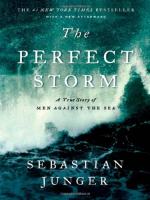
|
| Name: _________________________ | Period: ___________________ |
This test consists of 5 multiple choice questions, 5 short answer questions, and 10 short essay questions.
Multiple Choice Questions
1. In the midst of the rescue attempt for those aboard The Satori, who pilots a small Falcon jet to the rescue site?
(a) Austin Mathis.
(b) Dave Coolidge.
(c) Daniel Kennedy.
(d) Daryl Samuels.
2. What is the name of the rescuer who takes every crew member of The Satori out of the rough, stormy waters and places them into a basket to be hoisted to safety?
(a) Dave Moore.
(b) Kevin Carrothers.
(c) Tony Matula.
(d) Walt Phillips.
3. Which of the following job titles identifies Judith's position aboard the vessel in which she rides out "The Perfect Storm"?
(a) Compliance Officer.
(b) Public Information Officer.
(c) Safety Instructor.
(d) Excursion Coordinator.
4. In Chapter 7, Junger reports that mammals can survive up to one hour in very cold waters by which of the following?
(a) Diving reflex.
(b) Body heat generated by treading water incessantly.
(c) Wearing a survival suit.
(d) Natural body insulation.
5. Junger states that once flipped over due to storm conditions or overwhelming wave activity, the Andrea Gail was bound to have filled with water at which of the following temperatures?
(a) 45 degrees.
(b) 50 degrees.
(c) 40 degrees.
(d) 55 degrees.
Short Answer Questions
1. Author Sebastian Junger defines "larynospasm" as which of the following?
2. Sable Island is also known as which of the following?
3. What is the distance between the Andrea Gail and The Contship Holland during the time that "The Perfect Storm" is in full play?
4. Freak wave "monsters" are large waves that frequently overwhelm ships. How high was the largest wave of its type ever recorded that encountered a 478-foot Navy tanker?
5. How many years of experience at sea do Murph, Bugsy and Billy have among them?
Short Essay Questions
1. The biggest freak wave ever recorded is mentioned and described in Chapter 6. Explain the details of this event.
2. What unconventional rescue method described in Chapter 9 does the Air National Guard resort to for what results in the rescue of three of its own rescuers during the attempt to rescue a Japanese sailor off the New Jersey coast?
3. What type of obstacle does Coast Guard rescuer Dave Moore have to overcome during his attempt to save those who had been aboard The Satori?
4. Describe the four classifications that Junger writes about in Chapter 5 in relation to the method used by fishermen for gauging the velocity of a windstorm.
5. Describe the life-saving technique that Ernie Hazard used as it is explained in Chapter 7.
6. In Chapter 5, what does Junger describe as the action that a boat crew takes when they hear reports that a storm is hitting a boat at sea?
7. In Chapter 5, which five different directions do five different vessels head toward as those at their helms learn about the forecast concerning the forthcoming "Perfect Storm"?
8. What does "wave energy rising to the fourth power during storms" mean, as explained in Chapter 6?
9. What method of transportation, as described in Chapter 8, is used to shuttle those who had been on The Satori to safety?
10. In Chapter 6 ,it appears as though Sebastian Junger has included a statement in favor of oceanic preservation and against the dumping of petroleum in the ocean. What is Junger's approximate statement about this matter?
|
This section contains 1,058 words (approx. 4 pages at 300 words per page) |

|




